There are two takeaways from the Roving Ravenous Horde’s 26th outing. First, we’ve likely found the best Middle Eastern food in the city of Buenos Aires, period. In fact, some of the best I’ve had anywhere. And, as one of our number put it, as he’s been eating at this place for four decades, it’s not even worth it to him to go to others, this place is so good. Second, I have to admit, sheepishly, given that I never bothered to check it out, that m’tabal and babaganoush are not the same dish just named in different dialects, but are two quite different dishes, the only real common thing being that they’re both based on baked or grilled eggplant. As a tangent to that, what I’ve been calling babaganoush when I make it isn’t, it’s m’tabal, and the same holds true at many restaurants I’ve been to.
The place? Hanan, Julian Alvarez 1272, Palermo. It’s a place I went to once before, during my intense Chronicles of Shawarma search. While the shawarma itself had been pretty good, albeit a bit different from most of the other versions I’ve tried, there was a distinct lack of service or warmth during the entire experience, and I’d simply never gone back. And, I have no way to know if we’d have had much the same experience had we not been with someone who has known the owners for forty years. There’s still a certain level of not paying attention to the room (and, once again, we were the only people there during the lunch hour), and having to call to them to get someone to come over. But at the least, talkative and friendly when at the table this time around. [In later 2019 and then early 2020, one after the other, the two parents passed away, and the sons decided to close the place.]
The owners are from a small city of 25,000 people about 20 miles north of Damascus, Saidnaya, which is one of the most important Christian pilgrimage sites in all of Syria. The famed convent of Our Lady of Saidnaya was built in the 6th century by Emperor Justinian I. That’s about as much as I know about it from a quick search. Hanan, the name of the wife half of the couple who own this place, means compassion or mercy in Arabic, and the husband’s name is Hanna, the masculine version, meaning bliss or happiness.
On to the food… starting with a selection of appetizers (with five of us at the table, we just went to town on small plates).
Excellent hummus, not overly pureed, so it still has some texture, and flavored with lemon, garlic, tahini, and plenty of paprika. The pita breads are still a little commercial, but they’re fresh, and served hot, and well made.
A beautiful fresh tabbuleh salad, chock-ful of parsley, tomato, onion, and bulgur wheat and with a well balanced lemon and olive oil dressing.
The star of the day, and what led to our second takeaway above, a simply stunning m’tabal, packed with smoky eggplant and well spiced. So, what’s the “official” difference between the two? M’tabal is a puree of smoky grilled eggplant flavored with tahini, often (though not always) yogurt, and garlic. Babaganoush is more of a coarse mash of either baked or lightly grilled eggplant, therefore generally not smoky in flavor, and it’s mixed with tomato and onion, and sometimes pomegranate molasses. No tahini, which seems to be one of the critical points of difference.
Falafel are so often dense and/or dry, that much as I like their flavor, I’m almost always disappointed with them. These are light and juicy on the inside – I have no idea what they do differently, but I’m glad they do. They’re also packed with flavor.
And the second favorite of the day, raw kebbeh, ground beef and bulgur wheat with little seasoning, just freshly made and pretty much perfect. You can actually hear them grinding the meat to order when you make it, and they clearly pass it through the grinder at least a few times to get a silky, almost puree texture. So different from the versions I’ve had elsewhere it was like another dish.
Nicely executed stuffed grape leaves, iabra, as they refer to them, filled with rice and meat. I’d say these were my least favorite dish on the table, but that’s like saying my least favorite chocolate truffle in a box of exquisitely made ones.
Spicy, garlicky kafta spiced with onion, parsley, and bell pepper, and glazed with pomegranate juice. Again, some of the best I’ve had.
And, an unusual dish, a “specialty of the house”, the ouzi, a phylo dough wrapped pocked of rice, beef, almonds, and pinenuts, baked to a crisp, golden brown.
Actually, I have to say this was my least favorite plate, though I was the only one at the table who felt that way I think. Well made bakhlava, but for me, just too perfumed with rosewater.
And, because one of our number at the table is allergic to walnuts, they brought him a portion of imported halwah with fresh Iranian pistachios. A little dry, but great flavor.
And, we finished off with a round of sweet, thick, Arab-style coffee, poured tableside.
Overall? Pretty room. Service was, as I said, friendly and talkative, though I chalk some of that up to being with someone they knew, as they were still pretty inattentive except when called to the table. Food? As I said at the start, the best Middle Eastern food I’ve had in Buenos Aires, bar none. And, pretty inexpensive. All the appetizers and desserts run between 95-110 pesos, under $5, while the two main courses ran 160 pesos each, or a little under $7 each. All told, for five of us, with tip, we spent 2450 pesos, or $105 – $21 apiece. Can’t beat that!
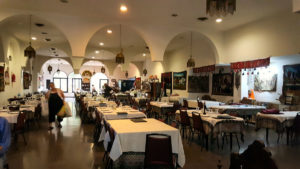
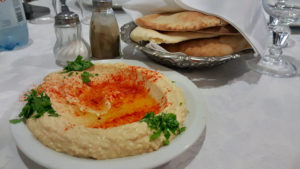
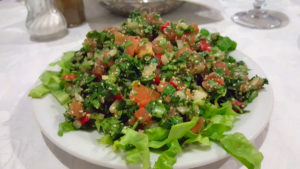
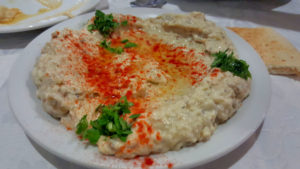
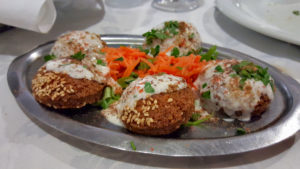
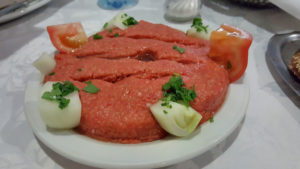
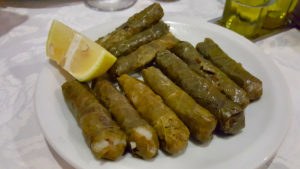
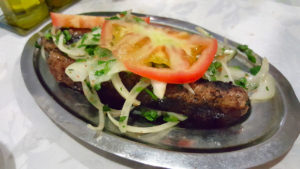
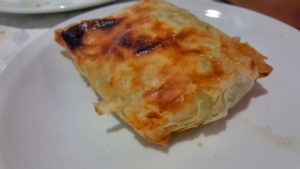
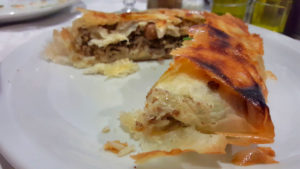
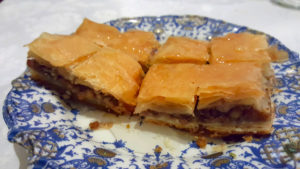
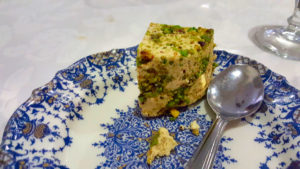
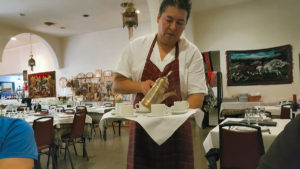
Sorry we missed it. Sounds like what we’re looking for.
I will definitely go then. Thanks!
You’re welcome!